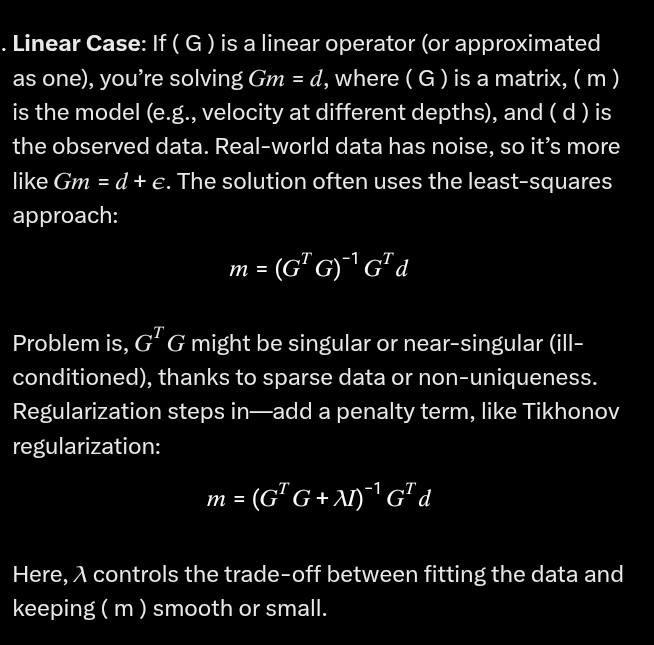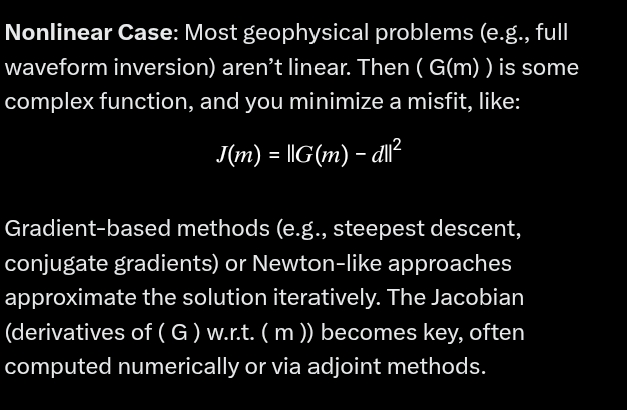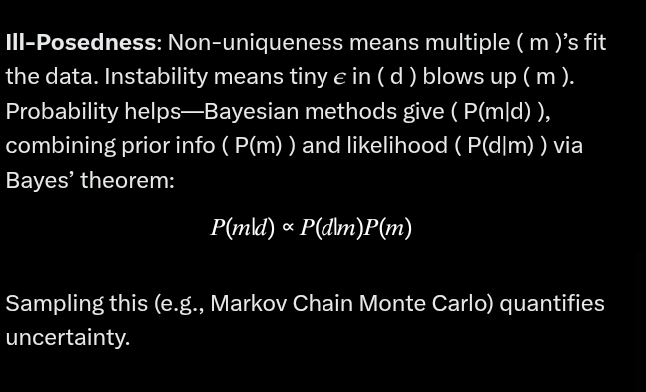Inverse problems in geophysics involve determining the physical properties of the Earth’s subsurface (like density, velocity, or conductivity) based on indirect observations, such as seismic waves, gravity measurements, or magnetic fields. Unlike forward problems, where you start with a known model and predict the data (e.g., how seismic waves propagate through a given structure), inverse problems work backward: you have the data and need to infer the model that produced it.
These problems are inherently tricky because they’re often ill-posed. This means there might be multiple models that fit the data equally well (non-uniqueness), or small noise in the data can lead to wildly different solutions (instability). To tackle this, geophysicists use techniques like regularization (adding constraints to favor simpler or more realistic models), least-squares optimization, or probabilistic methods like Bayesian inference to estimate uncertainty.
For example, in seismic tomography, you record wave travel times from earthquakes or controlled sources and try to reconstruct a 3D velocity model of the Earth’s interior. The data’s sparse, noisy, and the math involves solving large systems of equations—think millions of unknowns. Another case is gravity inversion, where you measure tiny variations in gravitational pull to map subsurface density, like finding oil reservoirs or fault lines.
The field’s a blend of physics, math, and computation. Tools like linearized inversion (assuming small perturbations) or full nonlinear approaches (e.g., Monte Carlo sampling) get used depending on the complexity. It’s critical for stuff like resource exploration, earthquake studies, and even planetary science—think of how we map Mars’ interior with limited data.
Applications
Inverse problems are everywhere in geophysics—here’s where they shine:
- Seismic Imaging: Reconstruct subsurface velocity/density from wave travel times or waveforms. Used in oil/gas exploration (finding reservoirs), earthquake hazard mapping (fault zones), and global seismology (Earth’s mantle/core structure).
- Gravity and Magnetics: Measure gravitational or magnetic anomalies to infer density or magnetization contrasts. Think mineral deposits, tectonic boundaries, or even archaeology (buried structures).
- Electromagnetics: Map subsurface conductivity for groundwater, geothermal resources, or contaminant plumes. Time-domain or frequency-domain data gets inverted.
- Planetary Science: With sparse data (e.g., Mars lander seismometers), inverse methods model alien interiors. Same goes for Earth’s Moon or exoplanet studies.
- Climate and Glaciology: Invert ice-penetrating radar to map ice thickness or bedrock, critical for sea-level rise predictions.
Techniques
Here’s the toolbox geophysicists pull from:
- Linearized Inversion: Assume small perturbations around a starting model. Fast but limited—good for initial guesses or simple problems like 1D resistivity.
- Full Waveform Inversion (FWI): Nonlinear, uses entire seismic waveforms, not just travel times. Computationally brutal but high-resolution—think supercomputers solving wave equations backward.
- Regularization: Tikhonov (smoothness), sparsity (e.g., L1 norms for sharp boundaries), or total variation. Keeps solutions realistic when data’s incomplete.
- Bayesian Inference: Model as a probability distribution. Monte Carlo methods or variational approximations sample it. Slow but gives uncertainty, vital for risky decisions (e.g., drilling).
- Adjoint Methods: Efficiently compute gradients in nonlinear problems. Instead of perturbing every model parameter, solve a companion “adjoint” problem—huge in FWI.
- Machine Learning: New kid on the block. Train neural nets on forward models to approximate inverses or guide traditional methods. Promising for speed, but needs tons of data.
- Joint Inversion: Combine datasets (seismic + gravity + magnetics) to reduce ambiguity. More constraints, better models.
The Mathematics
Linear Case

Nonlinear Case

Ill-Posedness
